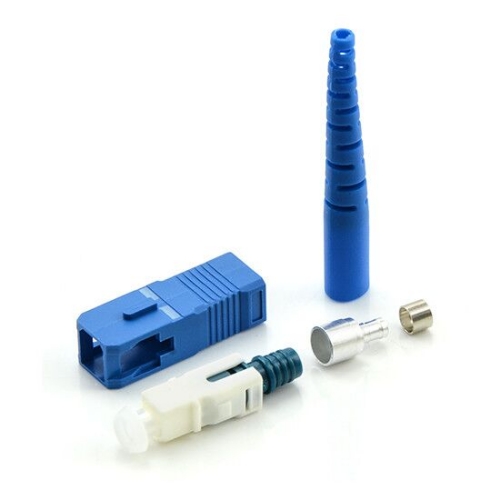Two Types of Fiber Optic Termination: Connector and Splicing
Fiber optic termination refers to a physical connection of fiber or wire to a device. It is a necessary step for installing a fiber optic network, which provides easy ways for fiber cross connection and light wave signal distribution. There are generally two ways how we terminate fiber optic cables, using connectors or splicing.
Connector Termination Introduction
Designed connectors can be put at the end of a fiber optic strand when terminating a fiber optic cable. Since fiber optic technology was introduced decades ago, numerous connector styles such as SC, FC or LC have been developed. There are three main components of a fiber optic connector: the ferrule, the connector, and the coupling mechanism. More detailed information is involved in Fiber Optic Connector Tutorial.
Traditional Epoxy and Polish Fiber Connectors
Epoxy or Polish Fiber Connectors are very traditional and widely used connectors. You may find that most factory-made connectors are epoxy or polish style owing that the epoxy or polish type is relatively reliable with low cost and low loss through a multi-factor consideration. The fiber is glued into the connector with epoxy and the end polished with a special polishing film. Such traditional epoxy and polish fiber connectors are needed for the applications where a large number of connectors will be used.
Quick Termination Fiber Optic Connectors
For quick termination fiber optic connectors, there has been a fiber stub bonded into the ferrule, where the end face of the ferrule is polished to a PC/UPC/APC finish. The other end of the fiber is cleaved and resides inside the connector body. It is more costly than the epoxy and polish fiber connectors. The following figure shows the quick termination fiber optic connector assemblies from FS.

Figure 1: FS customized SC fiber connector
It is recommended to monitor the loss with a visual fault locator when terminating them because once there is something wrong with the termination process, you will lose both the connector and the two splices. It is applicable for situations where few connectors will be used and where it is often the case to move, add, change or test.
Splicing Termination Type
Splicing is another commonly used termination type in field termination without any connectors. It can be further subdivided into mechanical splicing and fusion splicing.
Mechanical Splicing
Mechanical splicing is a junction of two or more optical fibers, which are precisely aligned and held in place by a mechanical assembly. It should be noted that the fibers that are mechanically spliced together are not permanently joined, just precisely held together enabling light to pass from one fiber into the other.
Due to the feature that the whole process of mechanical splicing is relatively fast and easy, it is normally used when time and professional skills are limited. For indoor transmission cables, fiber optic technicians often use mechanical splicing.
Fusion Splicing
Fusion splicing achieves fiber optic termination with heat generated by an electric arc, which is also called arc fusion. Different from mechanical splicing, fusion splicing requires a fusion splicer, indicating it’s more expensive. When the fusion splicing process begins, you should remove all the protective coatings from the ends of each optical fiber, then cleave the fibers with high precision fiber cleavers and align the fiber ends using a fusion splicer machine, and finally, make them “fused” or “welded” using the electric arc. The following image shows a fusion splicer of FS.

Figure 2: Fusion Splicer
Fusion splicing is usually used for outdoor, long-haul and high-performance single mode networks. What’s more, in factories where fiber optic devices such as fiber lasers and amplifiers are manufactured, fusion splicing is also needed. The two splicing steps and comparisons are available in Fusion Splice vs. Mechanical Splice.
Connectors Termination vs. Splicing Termination: Which Is Better?
There is no such a uniform standard to judge whether connectors termination or splicing termination is better. Choosing which one is better depends on various elements. You may get some help from referring to the benefits and drawbacks listed below.
What Are Benefits and Drawbacks of Connectors Termination?
Benefits
In comparison with splicing termination, using connectors is easier to operate and more time-saving and money-saving without the need of a splicer machine.
Drawbacks
The optical loss using connectors termination is higher than that of splicing termination.
What Are Benefits and Drawbacks of Splicing Termination?
Benefits
Comparing to using connectors, splicing not only provides a stronger and more reliable joint but also introduces much lower insertion loss.
Splicing can be used to mix several different types of fiber optic cables, for instance, connecting a 48-fiber cable to six 8-fiber cables.
Drawbacks
Splicing requires the operators equipped with specialized skills and the spending on the splicing assembly can be huge.
Since the limitation of assembly in storing capacity of the battery, it is not so convenient when working outdoor.
Conclusion
Except for the two types of field termination for fiber optic cables, the pre-terminated fiber optic cables are gaining more and more favor which enable immediate installation instead of having to terminate and test in the field. Even so, for some circumstances such as in long-haul transmissions or where wiring is hidden away in the wall, field termination seems better for its better flexibility. Overall, please take factors such as labor, tools, costs, and others into account and then decide which will work best for your project.
You might be interested in
Email Address

-
PoE vs PoE+ vs PoE++ Switch: How to Choose?
May 30, 2024













